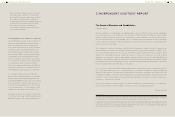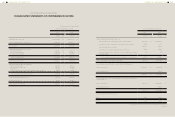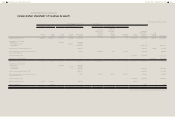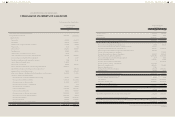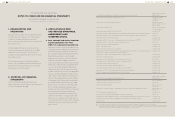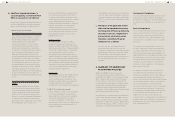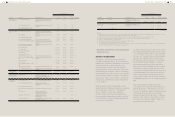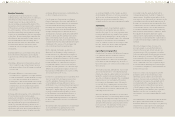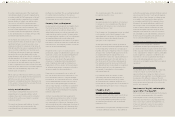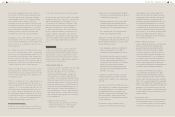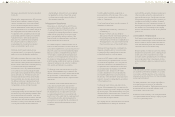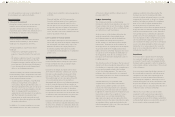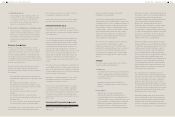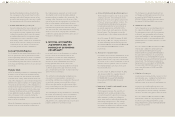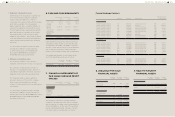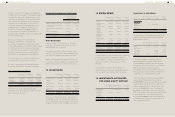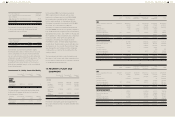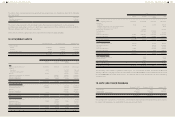HTC 2013 Annual Report Download - page 131
Download and view the complete annual report
Please find page 131 of the 2013 HTC annual report below. You can navigate through the pages in the report by either clicking on the pages listed below, or by using the keyword search tool below to find specific information within the annual report.
FINANCIAL INFORMATION FINANCIAL INFORMATION
258 259
the entire carrying amount of the investment
(including goodwill) is tested for impairment in
accordance with IAS 36 "Impairment of Assets"
as a single asset by comparing its recoverable
amount (higher of value in use and fair value
less costs to sell) with its carrying amount.
Any impairment loss recognized forms part of
the carrying amount of the investment. Any
reversal of that impairment loss is recognized in
accordance with IAS 36 "Impairment of Assets"
to the extent that the recoverable amount of the
investment subsequently increases.
The Company discontinues the use of the equity
method from the date on which it ceases to have
significant influence over the associate. Any
retained investment is measured at fair value at
that date and the fair value is regarded as its fair
value on initial recognition as a financial asset.
The difference between the previous carrying
amount of the associate attributable to the
retained interest and its fair value is included in
the determination of the gain or loss on disposal
of the associate. In addition, the Company
accounts for all amounts previously recognized
in other comprehensive income in relation to that
associate on the same basis as would be required
if that associate had directly disposed of the
related assets or liabilities.
When a group entity transacts with its associate,
profits and losses resulting from the transactions
with the associate are recognized in the
Company' consolidated financial statements only
to the extent of interests in the associate that are
not related to the Company.
Jointly controlled entities
Joint venture arrangements that involve the
establishment of a separate entity in which
venturers have joint control over the economic
activity of the entity are referred to as jointly
controlled entities.
The results and assets and liabilities of jointly
controlled entities are incorporated in the
consolidated financial statements using the
equity
method of accounting. The accounting treatment
for jointly controlled entities is the same as
investments in associates (please refer to Note 4
"Investments in associates" section).
Property, Plant and Equipment
Property, plant and equipment are tangible items
that held for use in the production, supply of
goods or services, for rental to others, or for
administrative purposes, and are expected to be
used more than twelve months. Property, plant
and equipment are stated at cost, less subsequent
accumulated depreciation and subsequent
accumulated impairment loss when it is probable
that future economic benefits associated with the
item will flow to the Company and the cost of the
item can be measured reliably.
Properties in the course of construction for
production, supply or administrative purposes are
carried at cost, less any recognized impairment
loss. Cost includes professional fees. Such
properties are classified to the appropriate
categories of property, plant and equipment
when completed and ready for intended use.
Depreciation of these assets, on the same basis
as other property assets, commences when the
assets are ready for their intended use.
Depreciation is recognized so as to write off
the cost of assets less their residual values over
their estimated useful lives, using the straight-
line method. The estimated useful lives, residual
values and depreciation method are reviewed
at the end of each reporting period, with the
effect of any changes in estimate accounted for
on a prospective basis in accordance with IAS
8 "Accounting Policies, Changes in Accounting
Estimates and Errors".
An item of property, plant and equipment is
derecognized upon disposal or when no future
economic benefits are expected to arise from
the continued use of the asset. Any gain or loss
arising on the disposal or retirement of an item of
property, plant and equipment is determined as
the difference between the sales proceeds and
the carrying amount of the asset and is
recognized in profit or loss.
Goodwill
Goodwill arising on an acquisition of a business
is carried at cost as established at the date of
acquisition of the business less accumulated
impairment losses, if any.
For the purposes of impairment testing, goodwill
is allocated to each of the Company's cash-
generating units (or groups of cash-generating
units) that is expected to benefit from the
synergies of the combination.
A cash-generating unit to which goodwill has
been allocated is tested for impairment annually,
or more frequently when there is an indication
that the unit may be impaired. If the recoverable
amount of the cash-generating unit is less than
its carrying amount, the impairment loss is
allocated first to reduce the carrying amount of
any goodwill allocated to the unit and then to
the other assets of the unit pro rata based on
the carrying amount of each asset in the unit.
Any impairment loss for goodwill is recognized
directly in profit or loss. An impairment loss
recognized for goodwill is not reversed in
subsequent periods.
If goodwill has been allocated to a cash-
generating unit and the entity disposes of
an operation within that unit, the goodwill
associated with the operation disposed of is
included in the carrying amount of the operation
when determining the gain or loss on disposal.
Intangible Assets
Intangible assets acquired separately
Intangible assets with finite useful lives that are
acquired separately are initially measured at
cost and subsequently measured at cost less
accumulated amortization and accumulated
impairment loss.
Amortization is recognized on a straight-line basis
over their estimated useful lives. The estimated
useful life, residual value, and amortization method
are reviewed at the end of each reporting period,
with the effect of any changes in estimate being
accounted for on a prospective basis which is
in accordance with IAS 8 "Accounting Policies,
Changes in Accounting Estimates and Errors".
The residual value of an intangible asset with
a finite useful life shall be assumed to be zero
unless the Company expects to dispose of the
intangible asset before the end of its economic
life. Intangible assets with indefinite useful lives
that are acquired separately are carried at cost
less accumulated impairment losses.
Intangible assets acquired in a business combination
Intangible assets acquired in a business
combination and recognized separately from
goodwill are initially recognized at their fair value
at the acquisition date (which is regarded as their
cost). Subsequent to initial recognition, intangible
assets acquired in a business combination are
reported at cost less accumulated amortization
and accumulated impairment losses, on the
same basis as intangible assets that are acquired
separately.
Derecognition of intangible assets
An intangible asset is derecognized on disposal,
or when no future economic benefits are
expected from use or disposal. Gains or losses
arising from derecognition of an intangible asset,
measured as the difference between the net
disposal proceeds and the carrying amount of the
asset, are recognized in profit or loss when the
asset is derecognized.
Impairment of Tangible and Intangible
Assets Other Than Goodwill
At the end of each reporting period, the Company
reviews the carrying amounts of its tangible
and intangible assets, excluding goodwill, to
determine whether there is any indication that
those assets have suffered an impairment loss.
If any such indication exists, the recoverable
amount of the asset is estimated in order to
determine the


